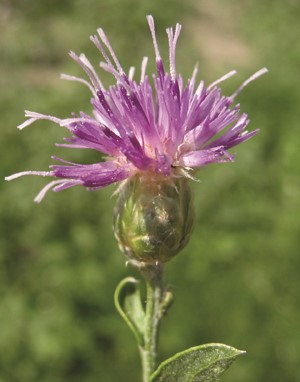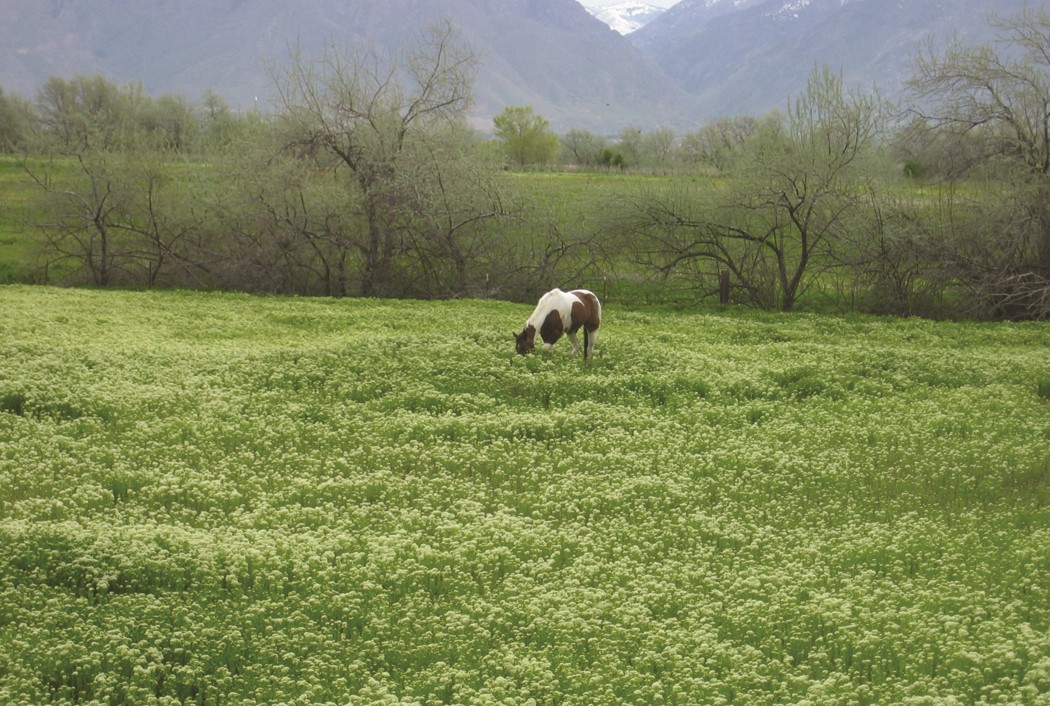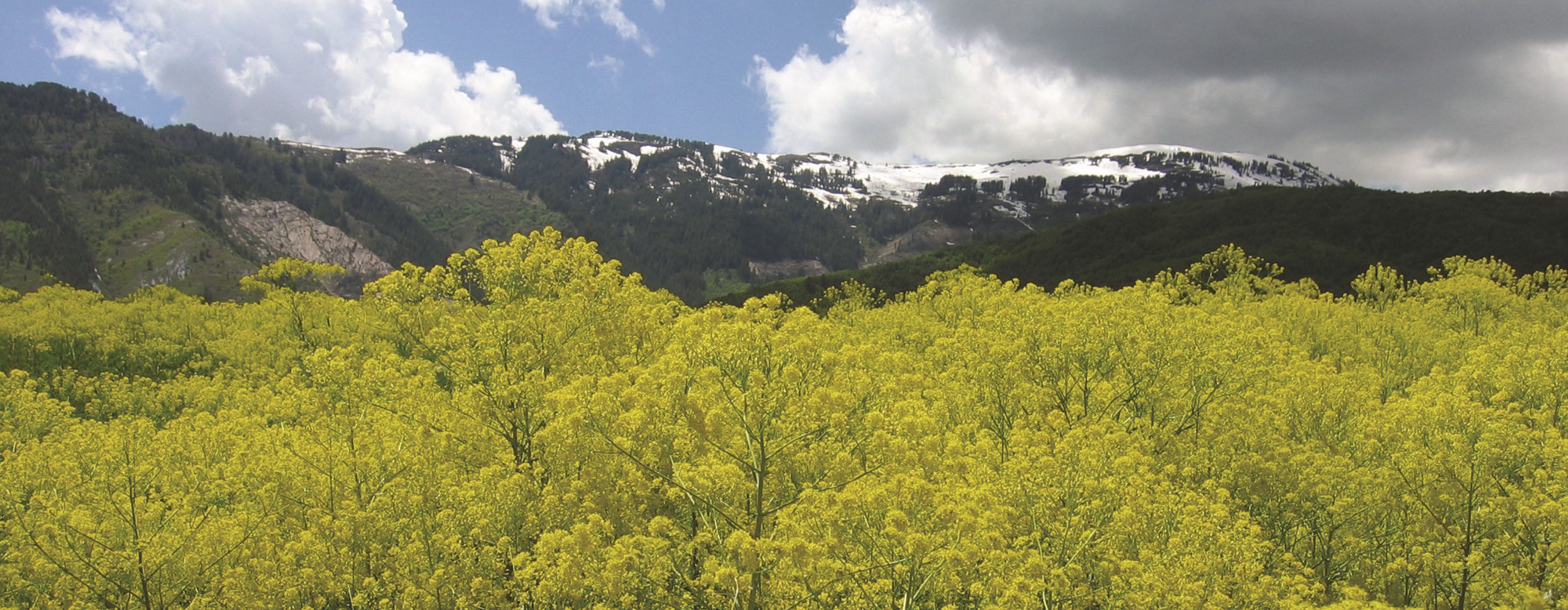012 - Common Weeds of Utah Forests
Introduction
The invasion of introduced plants into our forests is an ever-increasing threat. Every year, weeds are responsible for millions of dollars in losses of land production and control expenses. Weeds typically are spread easily and place the land into a state of unbalance due to their lack of natural predators. The weeds on the following pages are the most problematic species facing Utah forests today. Many of these weeds are unpalatable to wildlife and livestock and they may create a barrier to movement across the land. Weeds have the ability to outcompete native plants for light and nutrients, and they often inhibit the forest’s ability to regenerate in disturbed areas such as clearcuts, temporary roads, and burned areas. To keep forests free of weeds, be conscious of which weeds are present on your property and implement an integrated control plan. Be careful to prevent weed spread by not driving through infested areas and by keeping vehicles free of seeds and plant material. Remember that timing is critical - the earlier you apply treatments, the better chance you will have at successfully controlling weeds.
Knapweeds
Identification
Three of the most common knapweeds found in Utah are Russian knapweed (Acroptilon repens), diffuse knapweed (Centaurea diffusa), and spotted knapweed (Centaurea maculosa). All are native to Asia and thought to have been brought over in impure alfalfa seed. Although each has unique characteristics, all can reach about three feet tall and have tubular flowers like many other plants of the sunflower family. Russian and spotted knapweed typically have pink or lavender flowers while diffuse knapweed generally has white flowers, though it can have purple flowers as well.
All of these knapweeds have cup-like structures called involucres enclosing the base of the flowers covered in shingle-like structures called bracts. Russian knapweed has an urn-shaped involucre with solid green bracts that lie flat. Diffuse knapweed has a fairly narrow involucre, longer than it is wide and with bristles on the tips of the bracts. Spotted knapweed is one of the more recognizable of the knapweeds, with a vase-shaped involucre and bracts with dark brown tips giving it a spotted look.

Russian knapweed

Spotted knapweed

Diffuse knapweed
Ecology
Knapweeds are some of the most hardy weeds found in Utah. They can live in all moisture and temperature regimes as well as on both rocky and clay soils. However, they typically prefer open areas with deep, well-drained soils and adequate water. Reproduction can occur by seed or from lateral root sprouts. Seeds are not well dispersed by wind and typically rely on wildlife, waterways and vehicles for distribution. Some knapweeds will detach at the base and release seeds while tumbling along the ground. Recently burned areas, cultivated areas, and other locations that have undergone disturbance are the most likely places to find knapweed. They are also known for their ability to release chemicals which inhibit the growth of other plants.
Control
Knapweeds require an integrated management plan to control. Mechanical methods such as tilling and mowing will only stress the colonies without killing them. Chemicals such as 2,4-D, picloram (Tordon), and clopyralid plus 2,4-D (Curtail) are not fully effective unless much of the foliage has been removed by mechanical means such as mowing. The use of gall flies and moths as biological control agents is being explored to determine effectiveness. Combined mechanical and chemical methods are likely to be most successful.
Hoary Cress
Identification

Large infestation of hoary cress

Hoary cress
Hoary cress (Cardaria draba) is a perennial weed of the mustard family, native to southwest Asia. Leaves are bluish-green with bases that clasp around the stem. Flowers are white with four small petals arranged in a cross shape. The heads have a flat appearance with seeds that are enclosed in heart-shaped pods. Plants can reach up to two feet tall and have a widespread root system.
Ecology
Although the plant produces large quantities of viable seeds every year, populations usually spread most successfully through sprouting from extensive root systems. It is most commonly spread through waterways and along roads from human activity. Like most noxious weeds, hoary cress is unpalatable to most animals, especially after flowers have bloomed. Hoary cress is shade intolerant and prefers moist soils in irrigated meadows, roadsides and other disturbed sites.
Control
Mechanical and chemical control methods are considered moderately successful on hoary cress, especially when used in combination. Mowing, followed by applying herbicide, and then reseeding with competitive plants is probably the most effective means of treatment. Metasulfron (Escort), 2,4-D, and chlorsulfuron (Telar) have been proven effective on hoary cress. No biological control is currently available for hoary cress.
Musk Thistle
Identification

Musk thistle
Musk thistle (Carduus nutans) is an introduced plant of the sunflower family that originated from western Europe. It is easily identified by its large purple, or occasionally white, flowers that are surrounded by triangular, spine-tipped bracts resembling shingles folding down and away from the head. These large heads often bend to one side demonstrating the plant’s other common name of nodding thistle. Each plant can reach heights in excess of six feet and produce thousands of seeds yearly.
Ecology
Reproduction is achieved almost entirely by seeds, which have a cottony appearance and are able to travel several miles by wind. Musk thistle is considered a noxious weed due to its aggressive growth habit and unpalatable nature for wildlife and livestock. Left untreated, a few plants can turn into dense stands that crowd out native plants and reduce productivity. Areas most vulnerable to invasion are disturbed sites and roadsides with plenty of sunlight and moisture.
Control
The key to successfully controlling musk thistle is to prevent seed production. Mechanical, chemical and biological control methods are available for musk thistle. Mechanical control can be obtained by simply hand grubbing or tilling the weed before flowers begin to develop. Populations have been successfully controlled using mechanical methods as long as the plant is severed below ground. Mowing and other surface treatments are typically less efficient. Some of the more effective herbicides used for musk thistle include picloram (Tordon) or clopyralid plus 2,4-D (Curtail). Herbicides need to be applied either in spring or fall when plants are still in the rosette stages. A seed weevil that was a natural predator of musk thistle in Europe has been brought to the U.S. and is now being used as a valuable biological control agent.
Dalmatian Toadflax
Identification

Dalmatian toadflax
Dalmatian toadflax (Linaria genistifolia) resembles a snapdragon and was brought to the U.S. as an ornamental from Europe. Flowers are bright yellow with orange markings and elongated spurs extending to a point. Leaves have a bluishgreen appearance and a thick, waxy feel. Leaves are oval or heart-shaped and commonly clasp around the stem. Plants often grow in multi-stemmed clumps 1-3 feet tall.
Ecology
Toadflax is highly invasive due to its extensive, creeping root system, in addition to its ability to produce a large amount of seeds. Dispersal of the small, angular seeds occurs by animals, water and to some extent wind. Clearcuts, roadsides and other disturbed sites are the most commonly invaded areas. Toadflax is a somewhat unusual weed because it requires neither full sun nor moist sites like many weeds. Coarse, well-drained soils and low temperatures are also tolerated by toadflax, giving it an advantage over other plants.
Control
In order to successfully control toadflax populations, a combination of management strategies will likely be necessary. Mechanical methods such as hand-pulling or digging target areas have proven most successful; while mowing and tilling yield less desirable results. Herbicides such as picloram (Tordon) and chlorsulfuron (Telar) have some effect on toadflax but are not likely to provide adequate results alone. Several biological controls have been approved for use on toadflax, which range from shoot and flower-feeding beetles to defoliating moths. None of the control methods currently available are considered highly effective, which is why a mixture of methods will have the greatest chance of success.
Scotch Thistle
Identification

Scotch thistle
Scotch thistle (Onopordum acanthium) is a large, perennial weed native to Europe and Asia. It is most easily identified by its unusual stems, which have fin-like structures running vertically along the stem. Stems and leaves are quite hairy, giving them a gray, woolly appearance. Sharp spines are prevalent on this weed, especially near the flowers which are typically purple or lavender. Plants can reach heights in excess of eight feet.
Ecology
Scotch thistle reproduces entirely by seed, which can lie dormant in the soil up to 20 years. Seeds usually do not spread more than a few feet by wind but can be carried long distances by water, animals and human activity. Scotch thistle is commonly found in waste areas that have had some disturbance, but can also be found along stream corridors and other undisturbed areas with frequent moisture. Sandy and rocky soils are well tolerated, while low temperatures and reduced sunlight are most limiting for the plant.
Control
Because reproduction of Scotch thistle is only by seed, control can be achieved mechanically as long as the plant is severed below ground and no leaves are remaining. Tilling or digging the weeds by hand can provide desirable results. Mowing once will stress the plant and possibly delay seed production, but it is not a recommended method since it will not eradicate the population. Herbicides such as 2,4-D, picloram (Tordon), and clopyralid plus 2,4-D (Curtail) should be applied to rosettes in spring or fall. Biocontrol insects are still being evaluated.
Canada Thistle
Identification

Canada thistle
Canada thistle (Cirsium arvense) is a widespread perennial plant of the sunflower family, native to Eastern Europe and the Mediterranean. It can be distinguished from other thistles by its flower arrangement and characteristics as well as its height of only about three feet. Flower heads are rather small and purple or white without large spines like many other common thistles; flowers are also arranged in clusters of 3-5 rather than in single heads like musk thistle. Leaves of Canada thistle are light green with numerous spines and have a crinkled appearance. Given enough moisture, roots of Canada thistle can extend several feet deep and up to 15 feet horizontally.
Ecology
Reproduction of Canada thistle typically occurs by way of shoots from the broad root system and occasionally by seed. Riparian areas that have been previously disturbed are the most prone to infestation by Canada thistle. Wet meadows, irrigation ditches and marshes are especially susceptible, but Canada thistle can be found in any disturbed areas with enough moisture and sunlight. Heavily forested areas are less vulnerable to invasion because Canada thistle is considered shade intolerant; however, forest edges can still be overtaken by the weed. Although the plant is often spread by roots, seeds can be carried by animals, equipment and water.
Control
Controlling Canada thistle is a difficult task that usually requires two or more years of treatments. Possible methods that can be used to reduce populations include mechanical, chemical and biological agents. Mowing and tilling can be used in combination with herbicides to stress the thistle and allow more desirable species to compete. Chemicals often used in controlling Canada thistle include clopyralid plus 2,4-D (Curtail), picloram (Tordon), and glyphosate (Roundup). Few biological agents are available for use on Canada thistle and have a limited effect on whole populations. The most important factor in attempting to gain control over Canada thistle infestations is to sufficiently stress the entire clone and allow other species to compete.
Leafy Spurge
Identification

Leafy spurge

Leafy spurge can become quickly established in undisturbed areas
Leafy spurge (Euphorbia esula) is a perennial weed native to Europe, believed to have been brought to this country in loads of oats. Plants typically reach heights of three feet with deeply extending root systems. Leafy spurge can be easily identified by its milky juice that causes skin irritation and its unusual saucer-shaped, greenish-yellow flowers that lack petals. Leaves are several times longer than wide, having a reddish appearance when young and later turning green.
Ecology
Reproduction of leafy spurge will occur vigorously from both roots and numerous seed heads. Roots have been found to grow more than 10 feet vertically and horizontally, any part of which can regenerate a new plant. Seeds are enclosed in capsules which ultimately burst and disperse up to 15 feet in all directions. Most seeds will germinate within a year; however, they may last in the soil for up to 8 years. Seeds also float easily and therefore spread rapidly by water. Leafy spurge will colonize and reproduce on nearly all sites but prefers dry sites with a coarse soil; even heavily shaded woodlands are prone to infestation. Invasion into undisturbed areas is not uncommon, making it difficult to protect the land from new invasions.
Control
The only control method that has provided adequate control of leafy spurge is the use of chemicals. Tilling and other mechanical means of removal actually increase the number of shoots in an area. The use of fire or goats in combination with herbicide has proven the most effective method of control. Some chemicals approved for use on leafy spurge include picloram (Tordon), 2,4-D, and glyphosate (Roundup). A variety of insects have been introduced to offer control of leafy spurge with moderate success.
Dyer's Woad
Identification

Dyer's woad

Dyer's woad seeds
Dyer’s woad (Isatis tinctoria) is a noxious weed of the mustard family, originating from Europe. Plants are typically 2-4 feet tall with a rounded, umbrellashaped head of flowers. Each of the small flowers has four bright yellow petals arranged in a cross shape. The main stem of dyer’s woad is rounded in cross section and often turns purplish as it matures. Leaves have a bluish-green color with a prominent creamcolored vein running down the middle. Seeds of dyer’s woad are easily recognized as large black pods shaped like teardrops that will dangle from the stem around mid-summer.
Ecology
Almost all reproduction of dyer’s woad occurs by the large seeds. Dispersal of the seeds most commonly occurs along roadways and water since the seeds float. Disturbed sites are usually the first sites to become occupied, but rangelands and wooded areas are quickly invaded. Dyer’s woad also releases chemicals that inhibit the germination of other plants, giving it an extra advantage over native plants. Dry, rocky areas are most favored by this plant, often making it a difficult weed to control.
Control
Controlling dyer’s woad can be accomplished in a variety of ways. Hand pulling or digging just below the surface is the most effective and cheapest method for small populations as they appear throughout the summer. Mowing and tilling can be useful as long as it is repeated during the entire season to prevent seed production. Depending on the growth stage of the plant, several chemicals have been found to work fairly well on dyer’s woad: chlorsulfuron (Telar), 2,4-D, and glyphosate (Roundup). Biological control is still being researched; however, a native rust fungus has been found to be helpful in slowing the spread of populations.

Many areas like this have been completely taken over by weeds such as dyer’s woad.
Control Methods
The following table summarizes available control methods for the weeds outlined in this fact sheet.
| Species | Tilling & Herbicide | Mowing & Herbicide | Pulling | Digging | Glyphosate (Roundup) | Picloram (Tordon) | Curtail | 2,4-D | Biological |
|---|---|---|---|---|---|---|---|---|---|
| Knapweeds | ✔ | ✔ | ✔ | ✔ | ✔ | ||||
| Hoary cress | ✔ | ✔ | |||||||
| Musk thistle | ✔ | ✔ | ✔ | ✔ | ✔ | ✔ | ✔ | ||
| Dalmatian toadflax | ✔ | ✔ | ✔ | ✔ | ✔ | ||||
| Scotch thistle | ✔ | ✔ | ✔ | ✔ | ✔ | ✔ | |||
| Canada thistle | ✔ | ✔ | ✔ | ✔ | ✔ | ✔ | |||
| Leafy spurge | ✔ | ✔ | ✔ | ✔ | ✔ | ||||
| Dyer's woad | ✔ | ✔ | ✔ | ✔ | ✔ | ✔ | ✔ | ✔ |
Acknowledgements
Thanks to Wasatch County Cooperative Weed Management Area and Utah State University Extension personnel for reviewing this fact sheet, The Nature Conservancy, Pacific Northwest Weed Control Handbook, Colorado State University Extension and Douglas County Cooperative Extension of Colorado for their informative publications. USDA Forest Service State and Private Forestry and the Utah Division of Forestry, Fire & State Lands for their support.
Listing of commercial products implies no endorsement by the author or Utah State University Extension. Persons using such products are responsible for their use according to the current label directions of the manufacturer. The herbicide applicator is legally responsible for its proper use. Always read and follow the label.
Published September 2005.

